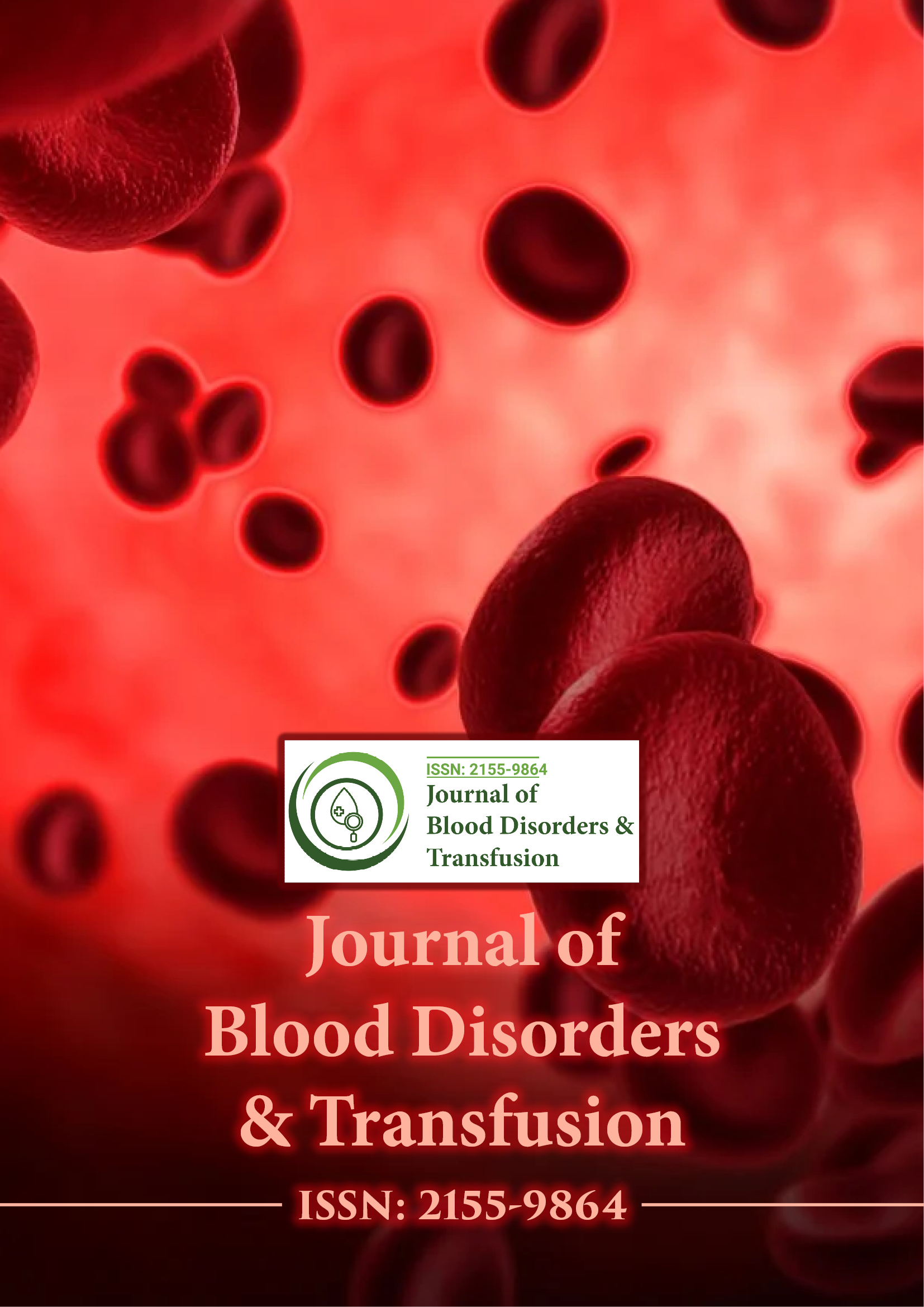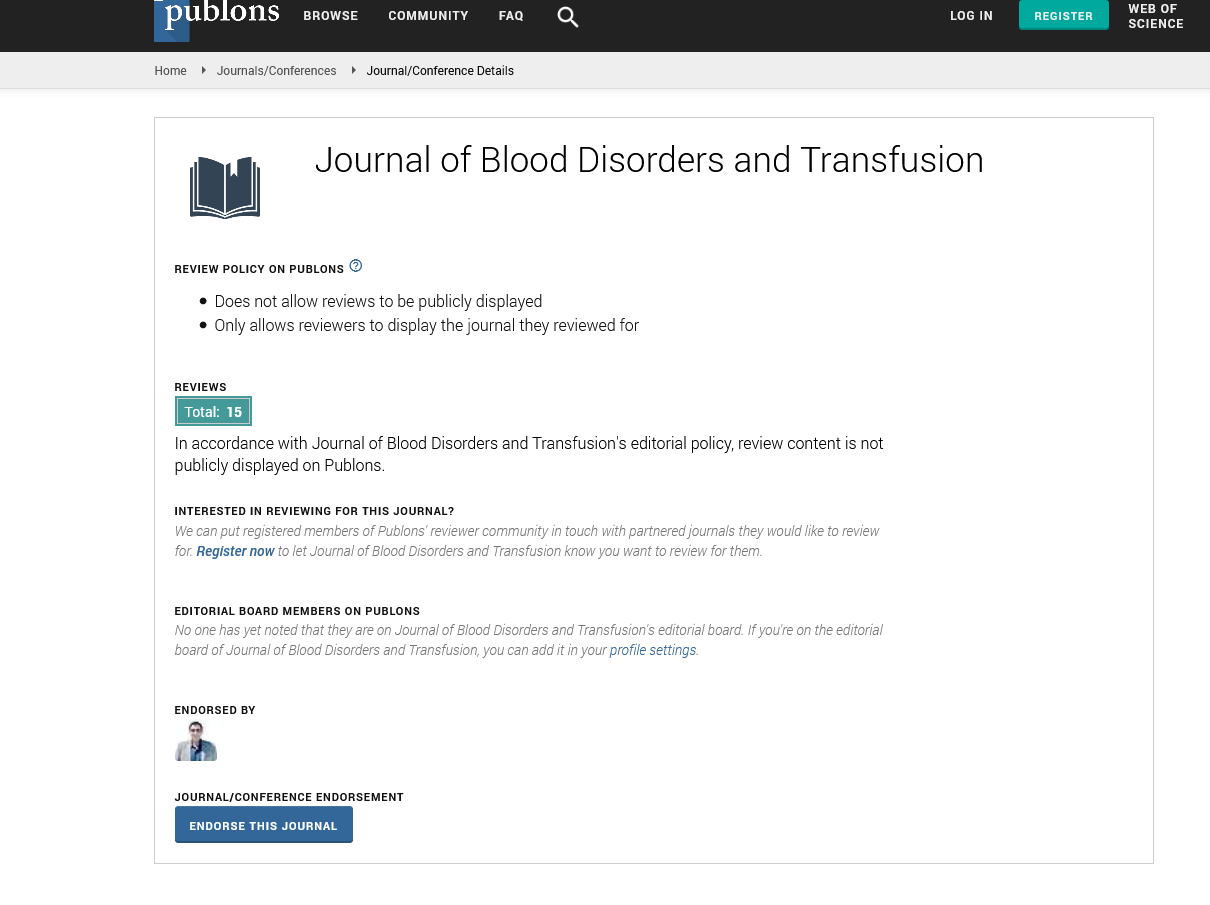Indexed In
- Open J Gate
- Genamics JournalSeek
- JournalTOCs
- Ulrich's Periodicals Directory
- RefSeek
- Hamdard University
- EBSCO A-Z
- OCLC- WorldCat
- Proquest Summons
- Publons
- Geneva Foundation for Medical Education and Research
- Euro Pub
- Google Scholar
Useful Links
Share This Page
Journal Flyer

Open Access Journals
- Agri and Aquaculture
- Biochemistry
- Bioinformatics & Systems Biology
- Business & Management
- Chemistry
- Clinical Sciences
- Engineering
- Food & Nutrition
- General Science
- Genetics & Molecular Biology
- Immunology & Microbiology
- Medical Sciences
- Neuroscience & Psychology
- Nursing & Health Care
- Pharmaceutical Sciences
Opinion - (2024) Volume 0, Issue 0
Transforming Hematologic Disorders: Advancements in Stem Cell Technology and Blood Disorder Management
Ferenz Vesna*Received: 28-Oct-2024, Manuscript No. JBDT-24-27700; Editor assigned: 01-Nov-2024, Pre QC No. JBDT-24-27700 (PQ); Reviewed: 15-Nov-2024, QC No. JBDT-24-27700; Revised: 22-Nov-2024, Manuscript No. JBDT-24-27700 (R); Published: 29-Nov-2024, DOI: 10.4172/2155-9864.23.S11.051
Description
Hematologic disorders, which encompass a wide array of conditions such as anemia, leukemia and lymphoma, have long posed significant challenges for healthcare professionals. Despite advances in treatment, many blood disorders remain difficult to manage, especially those that are genetically based or require a donor for bone marrow transplants. Recent breakthroughs in stem cell technology have begun to offer new possibilities in transforming the way these conditions are treated. This review explores the recent advancements in stem cell-based therapies and their impact on blood disorder management. We examine the mechanisms of stem cell therapy, including stem cell transplantation, gene editing and the use of Induced Pluripotent Stem Cells (iPSCs). Additionally, we analyze the future potential of these approaches in offering more effective and personalized treatment options for patients with hematologic disorders.
Hematologic disorders, including conditions such as anemia, leukemia, lymphoma, myeloma and other blood-related diseases, have significant global implications, affecting millions of individuals annually. Despite extensive research and therapeutic advancements, hematologic diseases continue to be challenging, often requiring complex, intensive treatments. Current treatments such as chemotherapy, radiation therapy and stem cell transplants have improved patient outcomes, but they are not without drawbacks, including immune rejection, high recurrence rates and limited availability of suitable donors. Recent developments in stem cell research have shown promise as a way to not only improve treatment efficacy but also provide more targeted and individualized therapies. This review discusses the role of stem cells in the management of hematologic disorders, highlighting recent advancements in stem cell technologies, therapeutic approaches and their clinical applications.
Stem cells are undifferentiated cells that have the ability to selfrenew and differentiate into various specialized cell types. In the context of hematology, Hematopoietic Stem Cells (HSCs) are of primary importance. These stem cells are located in the bone marrow and are responsible for generating the different types of blood cells, including red blood cells, white blood cells and platelets. Because of their ability to regenerate and replace damaged or diseased cells, HSCs play a central role in Hematopoietic Stem Cell Transplantation (HSCT), a treatment that has been used for decades to treat a variety of blood cancers and other hematologic disorders.
Hematopoietic stem cell transplantation has been a significant of therapy for disorders like leukemia, lymphoma and myelodysplastic syndromes. However, the procedure involves high-risk factors such as Graft-Versus-Host Disease (GVHD), immune rejection and the challenge of finding a suitable donor. Over the years, various advancements have aimed to reduce these risks and improve the efficacy of HSCT, with recent breakthroughs focused on increasing donor availability and improving immune compatibility between donor and recipient.
HSCT remains the standard treatment for many hematologic cancers, particularly leukemia and lymphoma. The success of HSCT largely depends on donor matching and post-transplant care. Over the past decade, improvements in donor registry systems and the use of umbilical cord blood as a source of stem cells have helped overcome some challenges, such as limited donor availability. Nevertheless, immune rejection remains a significant obstacle. Allogeneic HSCT, where the stem cells are taken from a donor, often leads to immune complications. In contrast, autologous HSCT, where patients receive their own stem cells, can mitigate this risk but is not always suitable for all patients, particularly those with advanced leukemia or other malignancies.
The discovery of iPSCs marked a significant turning point in stem cell research. iPSCs are derived by reprogramming somatic cells, such as skin or blood cells, into a pluripotent state, allowing them to differentiate into various cell types, including hematopoietic cells. This has intense implications for the treatment of hematologic disorders, as it allows for the generation of patient-specific stem cells, thus bypassing the need for donor matching and reducing the risk of immune rejection. By using iPSCs derived from a patient’s own cells, there is a potential to create genetically corrected blood cells, offering a much more personalized approach to treatment. Recent studies have demonstrated that iPSCs can be successfully differentiated into functional blood cells, including red blood cells and platelets, which could potentially be used for patients suffering from blood diseases like sickle cell anemia and beta-thalassemia. Though still in the early stages of clinical application, iPSCs represent a highly promising avenue for future therapies in hematology.
The advent of gene-editing technologies, particularly CRISPR-Cas9, has revolutionized the landscape of stem cell-based therapies. Gene editing allows researchers to make precise alterations to the DNA of stem cells, correcting the genetic mutations that underlie a variety of blood disorders. For example, sickle cell anemia and beta-thalassemia are caused by single-gene mutations in the hemoglobin gene, leading to the production of defective red blood cells. Using CRISPR-Cas9, scientists can correct these mutations in hematopoietic stem cells, allowing for the generation of normal, functional blood cells.
Preclinical studies and early clinical trials using CRISPR to correct the genetic defects responsible for sickle cell disease have shown promising results. Patients have experienced significant improvements in hemoglobin levels and reduced symptoms. While still experimental, gene editing represents a major leap forward in the potential to cure genetic blood disorders at the root cause, without the need for lifelong treatment. A major challenge in stem cell-based therapies is the limited supply of hematopoietic stem cells, especially in cases where a suitable donor is unavailable. One approach to addressing this issue is the ex vivo expansion of HSCs. This process involves cultivating stem cells outside the body in a controlled laboratory environment, where they can be stimulated to proliferate and increase in number. By using specific growth factors, cytokines and other signaling molecules, researchers have been able to expand the number of HSCs, which can then be transplanted into patients in need. Ex vivo expansion holds particular promise for individuals with blood disorders who do not have a suitable donor or for those who require a large number of stem cells for treatment. Clinical trials have shown that expanded HSCs can be successfully used for bone marrow transplantation, with the added benefit of reducing the likelihood of complications such as GVHD.
Citation: Vesna F (2024). Transforming Hematologic Disorders: Advancements in Stem Cell Technology and Blood Disorder Management. J Blood Disord Transfus. S11.051.
Copyright: © 2024 Vesna F. This is an open-access article distributed under the terms of the Creative Commons Attribution License, which permits unrestricted use, distribution, and reproduction in any medium, provided the original author and source are credited.

